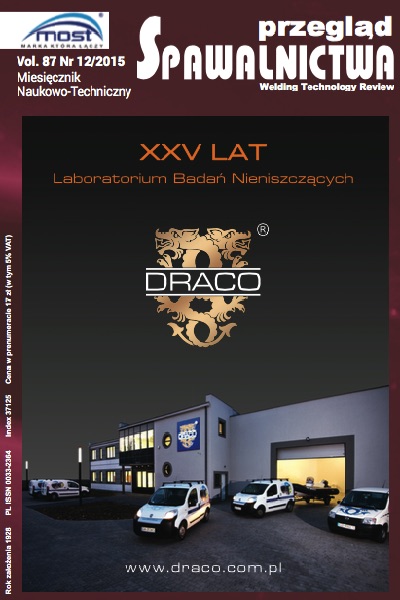Ocena wad i niezgodności spawalniczych metodą tomografii komputerowej CT
Main Article Content
Abstract
W artykule przedstawiono możliwość zastosowania badań metodą tomografii komputerowej CT do oceny struktury spawów. Metoda tomografii komputerowej w porównaniu do tradycyjnej radiografii daje dużo większe możliwości diagnozowania, kontroli złącz spawanych. Zwiększa się wykrywalność wad i niezgodności spawalniczych, co poprawia bezpieczeństwo eksploatacji. Metodą tomografii możemy dokładnie zwymiarować wadę we wszystkich jej kierunkach i zlokalizować przestrzennie w spoinie, co znacznie ułatwia diagnoście podjęcie ewentualnej decyzji o naprawie spawu lub całkowitym zbrakowaniu wyrobu. W artykule opisano także ograniczenia stosowania metody tomografii rentgenowskiej. Metoda ta jest szeroko wykorzystywana w przemyśle w procesie kontroli jakości produkcji jako metoda nieniszcząca NDT oraz w ramach profilaktycznych badań diagnostycznych.
The assessment of defects and discontinuities in weldings by means of computed tomography
In the paper a possibility of welding structure inspection by means of computed tomography was presented. In comparison to a traditional radiography, computed tomography method gives much more opportunities to diagnose and inspect welded joints. Thus it is easier to detect defects and discontinuities in weldings, what in turn increases safety of use. Tomography makes it possible to precisely attach to a defect dimensions in all directions and spatially localize it in a joint. This will help to take a decision regarding repair of the joint or consider a workpiece as a scrap. Limits of the use of computer tomography were also described. This solution is widely used in industry in production quality control process as a NDT method as well as in regular prevention diagnosis actions.
Downloads
Article Details
Creative Commons CC BY 4.0 https://creativecommons.org/licenses/by/4.0/
Welding Technology Review (WTR) articles are published open access under a CC BY licence (Creative Commons Attribution 4.0 International licence). The CC BY licence is the most open licence available and considered the industry 'gold standard' for open access; it is also preferred by many funders. This licence allows readers to copy and redistribute the material in any medium or format, and to alter, transform, or build upon the material, including for commercial use, providing the original author is credited.
References
J. Lewitowicz: Podstawy Eksploatacji Statków Powietrznych - Badania Eksploatacyjne Statków Powietrznych, T. 4., ITWL Warszawa 2007.
S.W. Rumiancew: Radiologiczne metody defektoskopowe, Ośrodek Informacji o Energii Jądrowej, Warszawa 1970.
J. Błachnio, A. Kułaszka: Computer aided visual inspection of the technical condition of gas turbine blades during their operation period. Journal of KONES Powertain and Transport, Vol. 16, No. 3, pp. 23-30, Warszawa, 2009.
Materiały z zakładu Radiografii Centrum Onkologii w Bydgoszczy: Rentgenowska tomografia komputerowa. Bydgoszcz.
Materiały z firmy Electronic Instrument Service: CT Rentgenowska tomografia komputerowa w zastosowaniach przemysłowych.
J. Błachnio, J. Pawlak: Damageability of gas turbine blades - evaluation of exhaust gas temperature in front of the turbine using a non-linear observer, w: Advances in Gas Turbine Technology, InTech, Warszawa 2011.
R. Cierniak: Computed Tomography. Design principles of CT equipment. Algorithms for recovering of images. Warsaw 2005 (in Polish).
M. Wieczorowski, B. Gapiński: X-ray CT in metrology of geometric feature, Acta Tehnica Corviniensis Bulletin of Engineering, VII, 1, 95-100, 2014.
